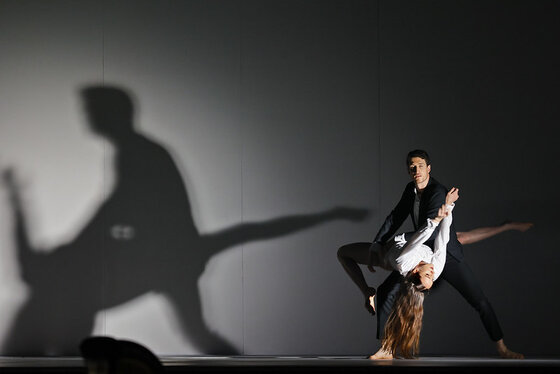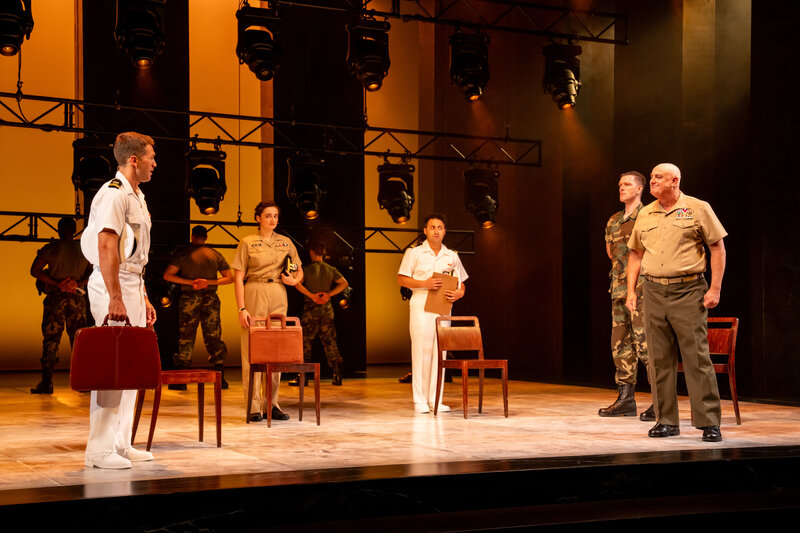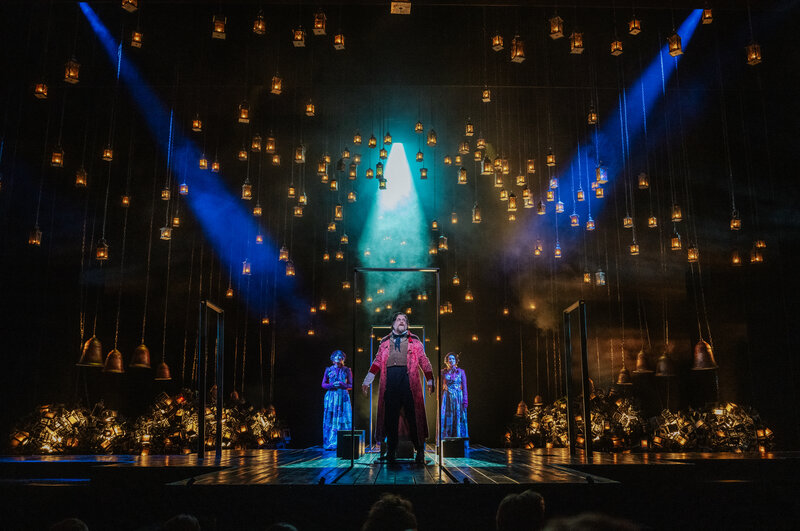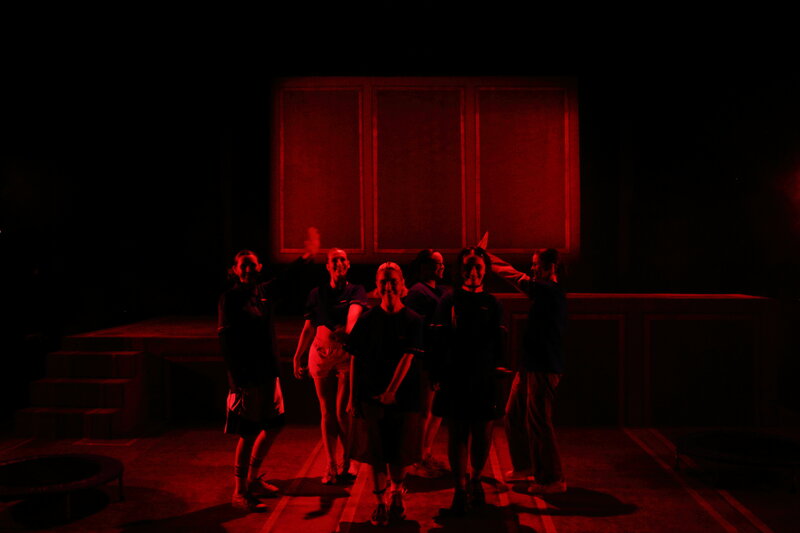Do Something Else is a new work devised by two dancers Cloe Fournier and Ryuichi Fujimura and sculptor/theatre maker Bridget Vidler with director Michael Pigott. Says Mr Pigott: “I was interested in seeing if you could make theatre that emulates thought processes, the different ways that we deal with material within our own minds; dreams, memory, the voices of doubt or excitement – the clarity of an image that emerges from all the white noise …
After watching the performance, I ask, is this the substance of this experience: While we are dong what we are doing, just what ARE we also thinking in a stream of unconsciousness? What lodges in our consciousness, and what does not? That the actual, perceptible narrative of our lives is that that the world sees but there is so much more to our inner narrative which only I know, and then know it, perhaps, only vaguely (unless I discipline my consciousness)? (Phew!)
 These four artists come from four different art disciplines and putting them together and wrestling with what turns up produces “a fractured dreamscape of overlapping forms. Where meaning and narrative emerge from the collision between imagery, movement, text and the manipulation of the space of the performers”.
These four artists come from four different art disciplines and putting them together and wrestling with what turns up produces “a fractured dreamscape of overlapping forms. Where meaning and narrative emerge from the collision between imagery, movement, text and the manipulation of the space of the performers”.
It is a fascinating premise and, certainly, the text and its structure has a provocation. It is, in my experience of it, however, a fairly dry and academic 75 minutes in the theatre. It cumulatively feels like a ‘performance art’ thesis paper put on the stage. Whilst the intellectual concept and distillation of the ‘workshopped’ investigation has some overall conviction it is the expression of it – finding the form to show us their content reckonings – from the artists themselves, that prevents the work from taking hold to support a visceral engagement in any way, other than as an intellectual vagary – (‘mind-fuck’).
Mr Pigott in his brief notes in the program hand-out tells us: “This is a devised piece of work that has been shaped by the performers and I over a series of workshops during the past year. The most interesting thing about working in this way is that it allows you to explore the connection between form and content and to experiment with ideas around the connection between form and content – about trying to articulate an idea through the way in which it is presented.”
So, it was, for me, essentially, the failure of these artists to ‘articulate’ the idea through finding a consistently ‘theatrical’ way/form, using their combined skills to express the content, that prevented the work from possibly taking imaginative flight and into the realm of cogency or excitement to be a witness of.
When Ms Fournier and Mr Fujimura engage, in what I imagine are the strengths of their dance/movement trainings and practise, they become articulate artists – one is compelled and one is delighted, awed, to pay attention. That those occasions were, relatively, scattered, and only a small part of the performance expression by them, highlighted, for me, a technical skill weakness to the ambitions of the production. That the physical life was not always examined or presented in all the opportunities of the stage time was a disappointment – there was a tendency for ordinary naturalistic gesture both physically and vocally that did not assist, support our necessary attention to the heightened intellectualisations of the text offers. There did not seem to be a ‘discipline’ of physical expression for all the work. Certainly, there was little vocal ‘discipline’ going on , from any of the performers, other than their natural, ordinary selves. The actions, body or voice did not suit, support or compel our focus to the textual investigation.
The subject matter of Do Something Else is a very challenging task to attempt to communicate and I sense that there has been some collaborative and intellectually dense preparation – hours and hours in the conversations to the conceptualisation, distillation and exploration of what ideas to explicate, and how to communicate these ideas. What I do not see is a similar preparation to consequently hone the physical skills and, from all, vocal skills, to deliver the material. The text is a ‘particular’ language expression. The ‘animal’ skills of the actors do not, generally, prepare us for this or assist us to engage consistently with that ‘particularity’ – which is quite demanding.
To be vulgar, artistically, the conversation I have had in discussing this work (and this ambitious performance merely brought it to a focus point – a ‘boiling point’) is to wonder how many hours, alongside the intellectual shaping of the work, were spent in finding the total physical language/form of expression for this task? How many hours were spent in preparing the vocal flexibilities and needs for the language/form communication necessary for this ‘heightened’ text stylisation? I argued with my companion, the ideal work schedule would be, at least, 4 hours of text prep, and at least 4 hours of body/physical prep, and 4 hours at least of vocal skill alerting. How near am I in hoping the Do Something Else workshops over the past year was spent in that kind of time allotted scheduling? Probably, way off – and sadly, it is, in my observation, the basic ‘animal’ and stylistic skills that are more often than not not practised in the preparation for performance of this kind of work (I believe , unfortunately, from most of my fellow performing artists, no matter what genre that are working in!)
 The inter-disciplinary requirements and respect and preparation of those skills to accurately elucidate the content of the performance is what has distinguished the work of Victoria Hunt – Copper Promises. The skills were rigorously attended too. I remember with vividness the performance of Tadeus Kantor’s The Dead Class, many years ago – a performance art piece of intricate intellectual propositions – where the physical expression of each of the artists involved was always being generated from an organic and common ‘life force ‘ of disciplined and decided technique from the word go. Each gesture, each sound, word sentence, had been honed to an exactitude of expression of meaning and intent. One was not able to look away as everything offered on stage was deliberate and informative. Active choices devised. Robert Wilson, Ariane Mnouchkine, Robert Le Page are other pursuers of this kind of form – it is, alarmingly, a time consuming process. But necessary to achieve clarity of objective.
The inter-disciplinary requirements and respect and preparation of those skills to accurately elucidate the content of the performance is what has distinguished the work of Victoria Hunt – Copper Promises. The skills were rigorously attended too. I remember with vividness the performance of Tadeus Kantor’s The Dead Class, many years ago – a performance art piece of intricate intellectual propositions – where the physical expression of each of the artists involved was always being generated from an organic and common ‘life force ‘ of disciplined and decided technique from the word go. Each gesture, each sound, word sentence, had been honed to an exactitude of expression of meaning and intent. One was not able to look away as everything offered on stage was deliberate and informative. Active choices devised. Robert Wilson, Ariane Mnouchkine, Robert Le Page are other pursuers of this kind of form – it is, alarmingly, a time consuming process. But necessary to achieve clarity of objective.
Do Something Else, while admittedly, far more developed dramaturgically, than The National Theatre of Parramatta’s production of The Cartographer’s Curse gave me a similar experience. It is in workshop mode. One wonders if this work needs nearly three weeks of exposure? It needs much more preparation in the way to express the highly investigated textual result for the general audience to grasp what you they are saying. The experiment for the form that Mr Pigott is searching for with his collaborators has not yet been found to clarify the content of their intellectual preoccupation.
Do Something Else as presented at Old 505 is a workshop iteration of their ambition. One presumes that this is not the end point of all the work so far investigated and unless you are particularly curious, you have to decide whether you choose to do something else, than go. Mind you, some in my audience seemed to get it. So…..?
Company: Laura Turner and Old 505 Theatre
Venue: Old 505 Theatre, Newtown, Sydney
Dates: to 22 October 2016
Kevin Jackson
For more of Kevin Jackson’s theatre reviews, check out his blog at Kevin Jackson’s Theatre Diary

David Edwards is the former editor of The Blurb and a contributor on film and television




